
Sekino Jun'ichirō (Japanese: 関野 凖一郎, born 1914 –1988) was a Japanese woodblock printer, one of the major postwar artists of the sosaku hanga ("creative print") movement.

Sekino Jun'ichirō (Japanese: 関野 凖一郎, born 1914 –1988) was a Japanese woodblock printer, one of the major postwar artists of the sosaku hanga ("creative print") movement.
Sekino Jun'ichirō was born in 1914 in the Yasukata district of Aomori, Aomori Prefecture, in northern Japan. From a young age he immersed himself in the study of printmaking. In middle school he started a magazine Ryokuju-mu ("Dream of Green Foliage") devoted to poetry and print. [1]
Sekino studied at Nishida Takeo's Japanese Etching Institute and enrolled at private school to learn oil painting and drawing. From 1931 he studied intaglio printmaking and lithography under Kon Junzō who considered his pupil "an artistic genius." [2]
In 1935 Sekino submitted an etching of Aomori harbor to a government sponsored Teiten exhibition and won a first prize. Later the same year he was awarded a prize for print exhibited at the Nihon Hanga Kyokai (Japanese Print Association). He joined the Nihon Hanga Kyokai in 1938, and the Kokugakai (National Picture Association) in 1940. [3]
In April 1939 Sekino moved to Tokyo where he was employed by publisher Shimo Taro and met Kōshirō Onchi. He was one of the founding members of Onchi's Ichimokukai (First Thursday Society), where he was considered Onchi's "right-hand man." During the Second World War, Sekino procured lodging and theater facilities for entertainment troupes. Through this role he met famous kabuki actor Nakamura Kichiemon I whose woodblock portrait he produced in 1947. Alongside further depictions of artists such as Shikō Munakata and Onchi, it became one of his most renowned pieces, and established him as the country's pre-eminent woodblock portraitist. [4]
Besides portraits, Sekino produced still lifes, landscapes (both rural scenes and cityscapes), depictions of animals, and abstract works. He also worked in lithography and etching, and in 1953 founded the Japanese Etchers Society. [5]
In 1958, at the invitation of the Japan Society, Sekino taught at America's Pratt Institute. In 1963 Gordon Gilkey of the Oregon State University hired him to teach a class. He also taught at the University of Washington and worked in New Mexico at the Tamarind Studio where he studied with Glen Alps, the inventor of collography. [6] In 1969 he returned to Oregon State where, in 1975, his series depicting the Fifty-three Stations of the Tōkaidō was exhibited with Hiroshige's famous 1834 version. [7]
Sekino was influenced by German Renaissance artist Albrecht Dürer and stated that, "one of the things I like most about him is his thoroughness, his corner-to-corner completeness." [8]
Sekino created over 400 prints. His years of studying printmaking techniques enabled him to produce work of a consistent and extremely high quality, in excess of most of his contemporary sosaku hanga artists. Onchi honoured him in allowing Sekino to reprint his Portrait of Hagiwara Sakutaro, and he assisted Maekawa Senpan in his Hot Spring Notes series.
As well as the Fifty-Three Stations, Sekino created series such as: Old Capital, Prints of the Narrow Road to the Deep North, Collection of Aomori Folk Toys and Collection of Famous Japan Folk Toys. He contributed to Onchi's 1945 series Scenes of Last Tokyo (Tokyo kaiko zue). [9] [10]

Sōsaku-hanga was an art movement of woodblock printing which was conceived in early 20th-century Japan. It stressed the artist as the sole creator motivated by a desire for self-expression, and advocated principles of art that is "self-drawn", "self-carved" and "self-printed". As opposed to the parallel shin-hanga movement that maintained the traditional ukiyo-e collaborative system where the artist, carver, printer, and publisher engaged in division of labor.

Shikō Munakata was a woodblock printmaker active in Shōwa period Japan. He is associated with the sōsaku-hanga movement and the mingei movement. Munakata was awarded the "Prize of Excellence" at the Second International Print Exhibition in Lugano, Switzerland in 1952, and first prize at the São Paulo Bienal Exhibition in Brazil in 1955, followed by Grand Prix at the Venice Biennale in 1956, and the Order of Culture, the highest honor in the arts by the Japanese government in 1970.
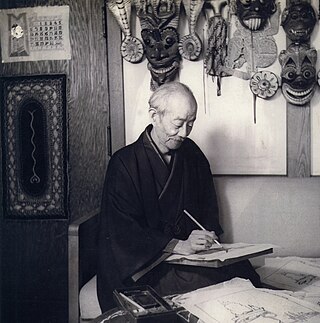
Hiroshi Yoshida was a 20th-century Japanese painter and woodblock printmaker. He is regarded as one of the greatest artists of the shin-hanga style, and is noted especially for his landscape prints. Yoshida traveled widely, and was particularly known for his images of non-Japanese subjects done in traditional Japanese woodblock style, including the Taj Mahal, the Swiss Alps, the Grand Canyon, and other National Parks in the United States.
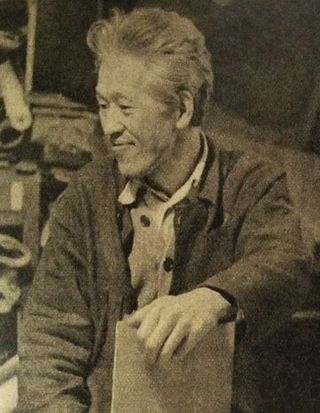
Kōshirō Onchi, born in Tokyo, was a Japanese print-maker. He was the father of the sōsaku-hanga movement in twentieth century Japan, and a photographer. His work was part of the painting event in the art competition at the 1932 Summer Olympics.

Masao Maeda was a woodblock print artist, born in Hakodate on the island of Hokkaidō, Japan.

Hiroyuki Tajima was a Japanese printmaker of the sōsaku-hanga school. He was born in Tokyo and graduated from Nihon University in 1932. In 1943, he graduated from the Western-style painting division of the Tokyo School of Fine Arts. He created his first print in 1946, and joined the Bijutsu Bunka Kyokai the same year. He also studied Nagase Yoshi (1891–1978), an artist of the Sōsaku-hanga school. In 1963, he became a member of the Nihon Hanga Kyokai.

Kanae Yamamoto was a Japanese artist, known primarily for his prints and yōga Western-style paintings. He is credited with originating the sōsaku-hanga movement, which aimed at self-expressive printmaking, in contrast to the commercial studio systems of ukiyo-e and shin-hanga. He initiated movements in folk arts and children's art education that continue to be influential in Japan.
Torii Kotondo or Torii Kiyotada V was a Japanese painter and woodblock printer of the Torii school of ukiyo-e artists. He followed his school's tradition of making prints of kabuki actors (yakusha-e) and involvement with commercial work for kabuki theater. His twenty-one bijin-ga are particularly celebrated.
Reika Iwami (岩見 禮花 Iwami Reika, was a Sōsaku-hanga woodblock printmaker who worked primarily with abstract compositions.
Kitaoka Fumio was a Japanese artist. He was trained in oil painting, and later became interested in woodblock printing.
Gihachiro Okuyama was a 20th-century Japanese commercial artist and woodblock printmaker. He was a prolific artist of the shin-hanga and sōsaku-hanga styles. Okuyama is noted for his landscape prints, both in color and black-and-white, as well as his simple prints of scenes that interject elements of the modernization of Japan into an otherwise traditional view.
Eiichi Kotozuka was a 20th-century Japanese commercial artist and woodblock printmaker. He was a prolific artist of the sōsaku-hanga style. He was one of four artists who co-founded the print publishing company Koryokusha. He was noted for his prints of Japanese cultural traditions, flowers, landscapes, and wildlife.

Shiro Kasamatsu was a Japanese engraver and print maker trained in the Shin-Hanga and Sōsaku-Hanga styles of woodblock printing.
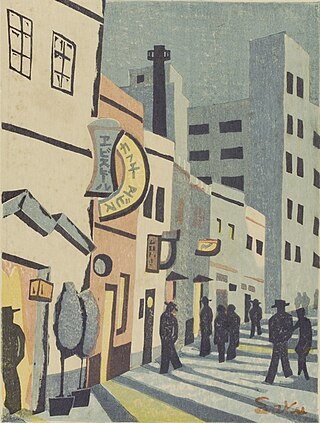
Sakuichi Fukazawa was a Japanese painter and woodblock printer working within the sosaku-hanga "creative prints" movement.
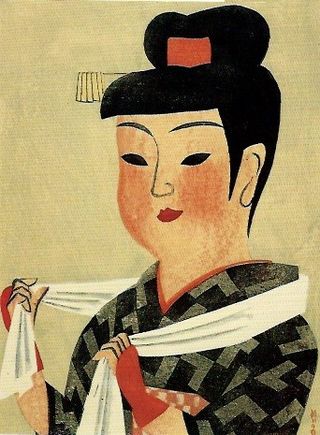
Senpan Maekawa was a Japanese woodblock printer associated with the sosaku hanga "creative prints" movement.

One Hundred Views of New Tokyo was a series of woodblock prints created from 1928 to 1932 by eight artists of the sōsaku hanga "creative print" movement.

Suwa Kanenori (1897–1932) was a Japanese painter and woodblock print artist associated with the sōsaku hanga movement.
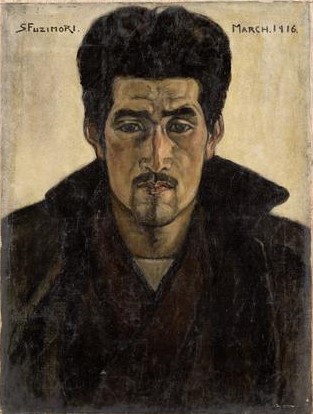
Fujimori Shizuo was a Japanese woodblock artist associated with the sōsaku-hanga movement. His style was strongly influenced by Expressionism.
Okiie Hashimoto was a Japanese artist and educator. Best known as part of the postwar revival of the sōsaku-hanga movement, he began his career as a school art teacher. In 1936, he began creating woodblock prints after he attended a workshop organized by prominent sōsaku-hanga artist Un’ichi Hiratsuka and began creating woodblock prints, which he successfully entered at major salon-style exhibitions in 1937. In 1939, he joined the newly formed First Thursday Society, which gathered around Kōshirō Onchi, who would become a leading figure in the postwar Creative Prints movement.
Ansei Uchima was an American artist and teacher primarily known as a sōsaku-hanga woodblock printmaker who employed traditional ukiyo-e Japanese techniques to produce abstract works covering a range of distinct personal styles.